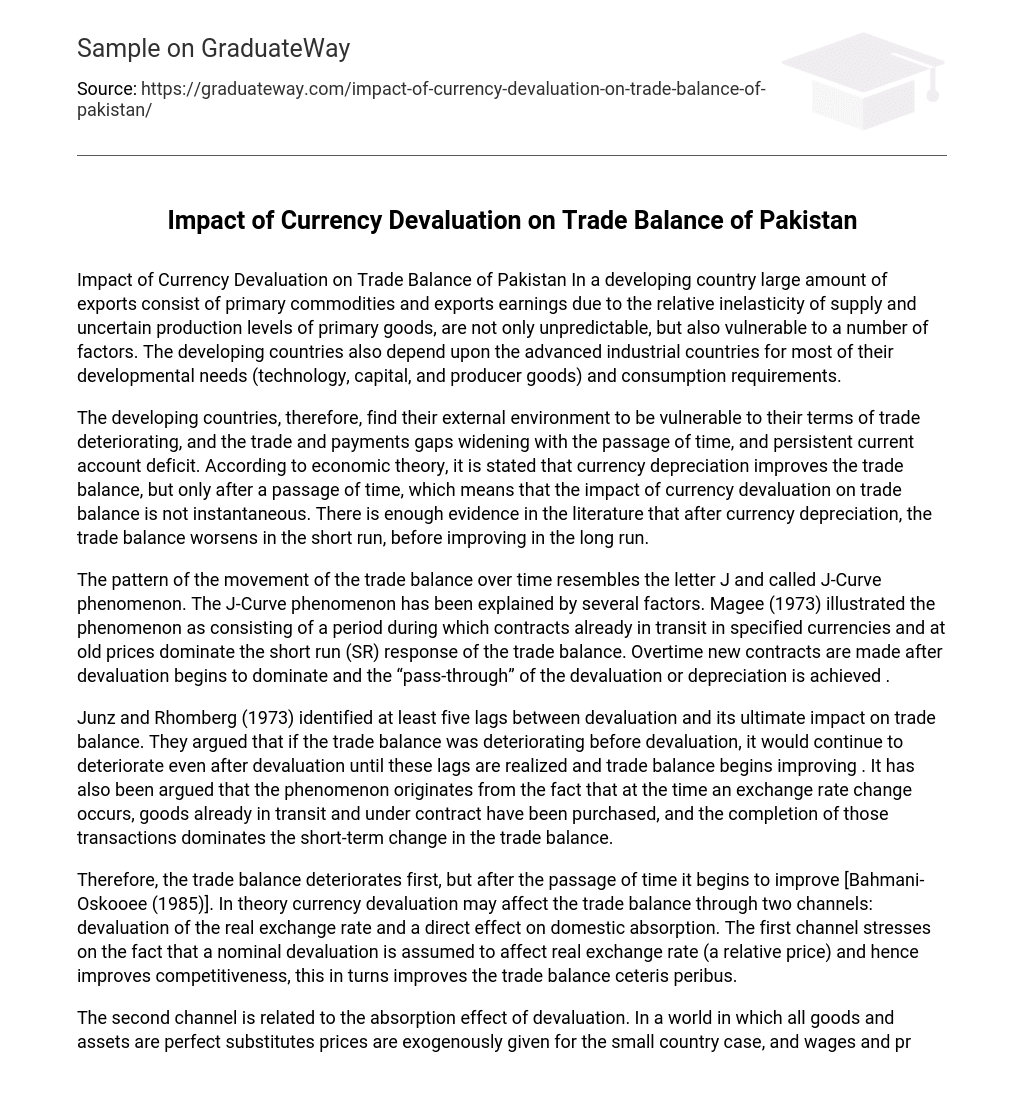Impact of Currency Devaluation on Trade Balance of Pakistan In a developing country large amount of exports consist of primary commodities and exports earnings due to the relative inelasticity of supply and uncertain production levels of primary goods, are not only unpredictable, but also vulnerable to a number of factors. The developing countries also depend upon the advanced industrial countries for most of their developmental needs (technology, capital, and producer goods) and consumption requirements.
The developing countries, therefore, find their external environment to be vulnerable to their terms of trade deteriorating, and the trade and payments gaps widening with the passage of time, and persistent current account deficit. According to economic theory, it is stated that currency depreciation improves the trade balance, but only after a passage of time, which means that the impact of currency devaluation on trade balance is not instantaneous. There is enough evidence in the literature that after currency depreciation, the trade balance worsens in the short run, before improving in the long run.
The pattern of the movement of the trade balance over time resembles the letter J and called J-Curve phenomenon. The J-Curve phenomenon has been explained by several factors. Magee (1973) illustrated the phenomenon as consisting of a period during which contracts already in transit in specified currencies and at old prices dominate the short run (SR) response of the trade balance. Overtime new contracts are made after devaluation begins to dominate and the “pass-through” of the devaluation or depreciation is achieved .
Junz and Rhomberg (1973) identified at least five lags between devaluation and its ultimate impact on trade balance. They argued that if the trade balance was deteriorating before devaluation, it would continue to deteriorate even after devaluation until these lags are realized and trade balance begins improving . It has also been argued that the phenomenon originates from the fact that at the time an exchange rate change occurs, goods already in transit and under contract have been purchased, and the completion of those transactions dominates the short-term change in the trade balance.
Therefore, the trade balance deteriorates first, but after the passage of time it begins to improve [Bahmani-Oskooee (1985)]. In theory currency devaluation may affect the trade balance through two channels: devaluation of the real exchange rate and a direct effect on domestic absorption. The first channel stresses on the fact that a nominal devaluation is assumed to affect real exchange rate (a relative price) and hence improves competitiveness, this in turns improves the trade balance ceteris peribus.
The second channel is related to the absorption effect of devaluation. In a world in which all goods and assets are perfect substitutes prices are exogenously given for the small country case, and wages and prices are flexible both in nominal and real terms, devaluation increases the price level by the same percentage, and the increase in real price reduces real balances and thus domestic absorption (Baharumshah 2001).
Previous studies that have been conducted to investigate the impact of currency depreciation on the trade balance have relied upon estimating the Marshall-Lerner condition that claims that depreciation improves the trade balance in the long run if sum of import demand elasticities are greater than one. In case of Pakistan, Hassan and Khan (1994) tried estimate the positive impact of devaluation on trade balance by testing the Marshall-Lerner condition and found that it holds for Pakistan.
Aftab and Aurangzeb (2002) conducted a study on Pakistan to examine the long run (LR) and short run (SR) impact of currency devaluation on Pakistan’s trade performance by using quarterly data and found out that in SR devaluation deteriorates the trade balance while LR improves it. Previous studies that were conducted used aggregate data. Now a new body of literature, points out that the lack of any significant relation between the trade balance and real exchange rate could have been due to aggregation bias.
These include Bahmani-Oskooee and Brooks (1999) who investigated the J-Curve pattern between US and her major trading partners by employing cointegration and error correction modeling. They showed that in SR the trade balance does not necessarily follow the J-Curve phenomenon while in the LR it shows improvement. Whereas, Bahmani-Oskooee and Kantipong (2001) tested the J-Curve phenomenon between Thailand and her larger trading partners, by using cointegration analysis and found evidence supporting J-curve in the case of US and Japan.
Another study conducted by Arora, Bahmani-Oskooee and Goswami (2003) tested J –Curve phenomenon between India and her major trading partners, which showed no evidence of J-curve pattern, while in LR currency depreciation of the rupee against the currency of Australia, Germany, Italy and Japan has positive impact on India’s trade balance. The main purpose of this study is to investigate the SR and LR effects of real depreciation of the rupee on Pakistan’s trade balance using bilateral trade and real exchange rate data comprising 10 major trading partners, which accounts for 53% of its trade share in 1990 .
They are United States of America (USA), The United Kingdom (UK), Canada, Germany, France, Italy, Netherlands, Singapore, Korea and Japan. In this paper the dis-aggregated quarterly data has been used, for the period 1971I-2003IV, in order to examine the LR and SR impact of currency devaluation on trade balance of Pakistan. The present paper has extended the earlier analyses regarding J-Curve phenomenon in Pakistan by using disaggregated bilateral quarterly data and employing granger causality test embodied in a Vector Error Correction (VECM) framework.





